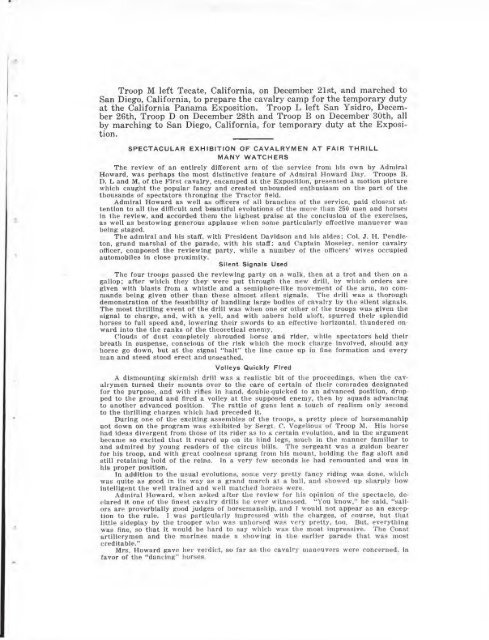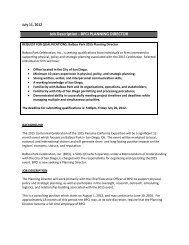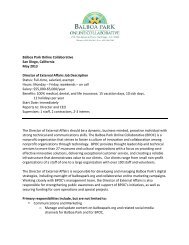Army and Navy Review 1915 Panama-California Edition - Balboa Park
Army and Navy Review 1915 Panama-California Edition - Balboa Park
Army and Navy Review 1915 Panama-California Edition - Balboa Park
Create successful ePaper yourself
Turn your PDF publications into a flip-book with our unique Google optimized e-Paper software.
Troop M left Tecate, <strong>California</strong>, on December 21st, <strong>and</strong> marched to<br />
San Diego, <strong>California</strong>, to prepare the cavalry camp for the temporary duty<br />
at the <strong>California</strong> <strong>Panama</strong> Exposition. Troop L left San Ysidro, December<br />
26th, Troop D on December 28th <strong>and</strong> Troop B on December 30th, all<br />
by marching to San Diego, <strong>California</strong>, for temporary duty at the Exposition.<br />
SPECTACULAR E X H IB IT IO N OF CA VALRYM EN AT FAIR T H R IL L<br />
MANY W AT CHERS<br />
The review of an entirely different arm of the service from his own by Admiral<br />
Howard, was perhaps the most distinctive feature of Admiral Howard Day. Troops B,<br />
D, L <strong>and</strong> M, of the First cavalry, encamped at the Exposition, presented a motion picture<br />
which caught the popular fancy <strong>and</strong> created unbounded enthusiasm on the part of the<br />
thous<strong>and</strong>s of spectators thronging the Tractor field.<br />
Admiral Howard as well as officers of all branches of the service, paid closest attention<br />
to all the difficult <strong>and</strong> beautiful evolutions of the more than 250 men <strong>and</strong> horses<br />
in the review, <strong>and</strong> accorded them the highest praise, at the conclusion of the exercises,<br />
as well as bestowing generous applause when some particularly effective manuever was<br />
being staged.<br />
The admiral <strong>and</strong> his staff, with President Davidson <strong>and</strong> his aides; Col. J. H. Pendleton,<br />
gr<strong>and</strong> marshal of the parade, with his staff; <strong>and</strong> Captain Moseley, senior cavalry<br />
officer, composed the reviewing party, while a number of the officers’ wives occupied<br />
automobiles in close proximity.<br />
Silent Signals Used<br />
The four troops passed the reviewing party on a walk, then at a trot <strong>and</strong> then on a<br />
gallop; after which they they were put through the new drill, by which orders are<br />
given with blasts from a whistle <strong>and</strong> a semiphore-like movement of the arm, no comm<strong>and</strong>s<br />
being given other than these almost silent signals. The drill was a thorough<br />
demonstration of the feasibility of h<strong>and</strong>ling large bodies of cavalry by the silent signals.<br />
The most thrilling event of the drill was when one or other of the troops was given the<br />
signal to charge, <strong>and</strong>, with a yell, <strong>and</strong> with sabers held aloft, spurred their splendid<br />
horses to full speed <strong>and</strong>, lowering their swords to an effective horizontal, thundered onward<br />
into the the ranks of the theoretical enemy.<br />
Clouds of dust completely shrouded horse <strong>and</strong> rider, while spectators held their<br />
breath in suspense, conscious of the risk which the mock charge involved, should any<br />
horse go down, but at the signal “halt" the line came up in fine formation <strong>and</strong> every<br />
man <strong>and</strong> steed stood erect <strong>and</strong> unscathed.<br />
Volleys Quickly Fired<br />
A dismounting skirmish drill was a realistic bit of the proceedings, when the cavalrymen<br />
turned their mounts over to the care of certain of their comrades designated<br />
for the purpose, <strong>and</strong> with rifles in h<strong>and</strong>, double-quicked to an advanced position, drop<br />
ped to the ground <strong>and</strong> fired a volley at the supposed enemy, then by squads advancing<br />
to another advanced position. The rattle of guns lent a touch of realism only second<br />
to the thrilling charges which had preceded it.<br />
During one of the exciting assembles of the troops, a pretty piece of horsemanship<br />
not down on the program was exhibited by Sergt. C. Vogelious of Troop M. His horse<br />
had ideas divergent from those of its rider as to a certain evolution, <strong>and</strong> in the argument<br />
became so excited that it reared up on its hind legs, much in the manner familiar to<br />
<strong>and</strong> admired by young readers of the circus bills. The sergeant was a guidon bearer<br />
for his troop, <strong>and</strong> with great coolness sprang from his mount, holding the flag aloft <strong>and</strong><br />
still retaining hold of the reins. In a very few seconds he had remounted <strong>and</strong> was in<br />
his proper position.<br />
in addition to the usual evolutions, some very pretty fancy riding was done, which<br />
was quite as good in its way as a gr<strong>and</strong> march at a ball, <strong>and</strong> showed up sharply how<br />
intelligent the well trained <strong>and</strong> well matched horses were.<br />
Admiral Howard, when asked after the review for his opinion of the spectacle, declared<br />
it one of the finest cavalry drills he ever witnessed. ‘‘You know,” he said, “sailors<br />
are proverbially good judges of horsemanship, <strong>and</strong> I would not appear as an exception<br />
to the rule. I was particularly impressed with the charges, of course, but that<br />
little sideplay by the trooper who was unhorsed was very pretty, too. But. everything<br />
was fine, so that it would be. hard to say which was the most impressive. The Coast<br />
artillerymen <strong>and</strong> the murines made a showing in the earlier parade that was most<br />
creditable.”<br />
Mrs. Howard gave her verdict, so far as the cavalry maneuvers were concerned, in<br />
favor of the “dancing” horses.







